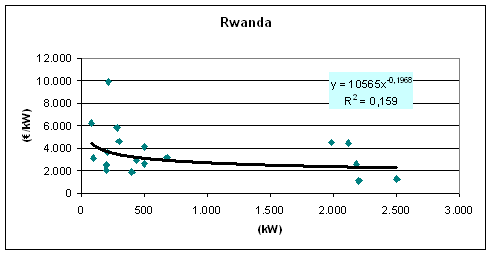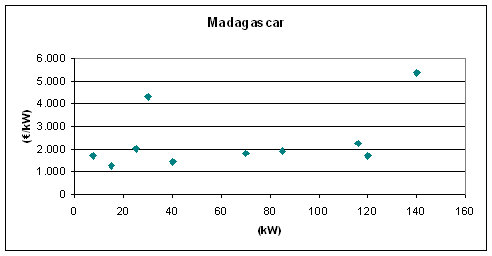Knowledge fuels change - Support energypedia!
For over 10 years, energypedia has been connecting energy experts around the world — helping them share knowledge, learn from each other, and accelerate the global energy transition.
Today, we ask for your support to keep this platform free and accessible to all.
Even a small contribution makes a big difference! If just 10–20% of our 60,000+ monthly visitors donated the equivalent of a cup of coffee — €5 — Energypedia would be fully funded for a whole year.
Is the knowledge you’ve gained through Energypedia this year worth €5 or more?
Your donation keeps the platform running, helps us create new knowledge products, and contributes directly to achieving SDG 7.
Thank you for your support, your donation, big or small, truly matters!
Micro-Hydro Power - Analysis of Costs
Overview
Literature on micro-hydro power (MHP) tells us that the cost of this type of installations ranges between 1.500 € and 3.000 € per kW installed. However, MHP projects promoted by PSP Hydro (GIZ / EnDev) in Rwanda have a cost per kW between 3.000 and 6.000 €. PSP Hydro provides technical assistance and financial support to local private SMEs for the design, construction and operation of MHP plants. It might be that this particular approach is the reason for such a high cost. However, compared to the costs of MHP plants totally financed by public funds confirmed that, general speaking, costs are higher in Rwanda than in any other countries within the region. The direct consequence of this is that MHP projects in Rwanda can not be developed without a grant of, at least, 50% of the total investment cost, which prevents the consolidation of private participation in the sector and limits the number of new projects that PSP Hydro can support. Therefore, PSP Hydro has started an analysis to identify the causes of such high costs in order to eventually find solutions. The initial results of this analysis are presented in this article.
Possible Causes
PSP Hydro, in discussion with other stakeholders within the MHP sector in Rwanda has already identified the following possible causes:
- Landlocked country: most of materials and equipment have to be imported. Since Rwanda is far from the sea, the transportation costs are quite significant.
- The Rwandan market is small: Rwanda is a small country with a weak industry and also an underdeveloped energy sector. As a consequence, demand for high technology equipment is low and price reductions can not benefit from massive importations.
- MHP plants are small: since the construction of a MHP project requires a relatively small quantity of materials, smaller MHP projects can not benefit from economies of scale.
- Need of foreign experts: Rwanda lacks of experts for the analysis, design and construction of MHP projects. The region does not have many experts in this field either. Therefore, experts have to be contracted, very often, outside the continent, which, for small-size projects, represents a quite significant economic burden.
- Very demanding local bank conditions: analogously to most of African countries, loan conditions offered by commercial banks in Rwanda are very demanding. In addition, banks in Rwanda are not used to deal with energy projects and perceive MHP as a risky sector. As a consequence, interest rates are very high and periods of return very short, which increases the total cost and the need of higher equity and grant contributions.
- Too high standards for electricity lines: RECO, the national utility, applies the same standards for electricity lines in rural and urban areas. These are the standards that the Ministry of Infrastructure considers as appropriate and MHP developers have to follow them. Since standards in rural areas could be lower without risk, the investment costs for LV and MV lines in the countryside of Rwanda are unnecessarily high.
- Turbine manufacturers consider Rwanda as a high risk country: turbine manufacturers, mainly from western countries, consider Rwanda to be a risky market to them. They fear that a sudden political change or a dishonest company can prevent them to sell equipment that has been ordered from Rwanda. To mitigate this risk, manufacturers opt to increase the price of the turbines sold in Rwanda in such a way that the sale of two of them can cover the cost of three in case that one can finally not be provided.
- Long execution periods: economic sector in Rwanda is still very young and its companies lack of managerial skills. This is also the case of companies within MHP sector. As a consequence, projects suffer long delays, which revert in additional unexpected costs.
- Donor contributions bring cheap money: most of MHP plants recently completed or under construction have been completely financed by public money. Since, in many cases, these funds come from donor contributions, the lack of ownership may cause a lack of responsibility for its efficient expenditure.
Data Collection
Over time, PSP Hydro has created a database with the detailed breakdown of costs of the MHP plants co-financed by GIZ/EnDev Rwanda. In order to complete this database, PSP Hydro has started a campaign of data collection of detailed breakdown of costs of MHP plants developed by other stakeholders in the country. Institutions that have provided information so far are: BTC, EU, MININFRA, UNIDO and SHER. PSP Hydro has also received information of MHP projects from GIZ/EnDev Ethiopia and GIZ Madagascar and will soon receive information from GIZ/EnDev Mozambique and GIZ/EnDev Uganda. Since most of the MHP projects from which data have been collected are still under construction, available information is not definitive yet. However, its provisional analysis can already provide clues for the confirmation or disregard of some of the above mentioned possible causes and the identification of new ones if any. Results of the analysis so far are shown in the next sections.
Result 1: Specific Cost (€/kW)
Figure 1 shows the cost per kW of several MHP plants in Rwanda. Most of the plants are at the level of 3.000 €/kW and above. In addition, the figure puts in evidence that economies of scale work for MHP and the specific cost (€kW) decreases when the size of the plant rises.
Figure 1: cost for MHP projects in Rwanda:
Plants that are below the threshold of 3.000 €/kW are the 7 plants financed by MININFRA and build by the Sri Lankan engineering company HPI. Their initial budget has recently been reviewed and it has been concluded that, in average, will have to be increased in 30-40% in order to conclude the works.
Figure 2 shows the cost of MHP plants in Madagascar. Compared to Rwanda, plants in Madagascar have a quite significant lower cost. This difference can be due to the fact that, in most of the cases, costs in Madagascar do not include the distribution system.
Figure 2: cost for MHP projects in Madagascar:
The bigger plant is one of the cases in which the cost of all components, including distribution, has been considered. This plant has a MV line of 20 km, which is significantly long for the small size of the generation capacity of the project and this may explain why the total cost is within the same range of costs as in Rwanda.
Result 2: Civil Works
Cement is a basic material for the civil works of a MHP plants because is a basic component of concrete. Rwanda has only one small cement factory which is not big enough to cover the local demand. As a consequence, cement has to be imported. Table 1 shows the differences in the cost of a 50 kg bag of cement in three different African countries. The cost in Rwanda is far above the other two countries. A reason for that may be the fact that Rwanda is a landlocked country and, in addition, has a small market. Kenya and Tunisia have direct access to the see and have bigger markets.
| Cost (RwF) | |
| Kenya | 6.400 |
| Rwanda | 11.000 |
| Tunisia | 2.500 |
Result 3: Distribution System
Table 2 shows that cost per km of both LV and MV lines in Rwanda are higher than in any other countries within the region. Since the cost in South Africa is similar to the one in Rwanda and standards in South Africa are higher than in other African countries, this could confirm that also standards in Rwanda are higher.
| LV (€/kW) | MV €/kW) | |
| Benin | -- | 16.000 |
| Ethiopia | 9.000 | -- |
| Madagascar | 7.600 | 10.600 |
| Rwanda | 20.000-30.000 | 60.000-75.000 |
| Senegal | 8.500 | -- |
| South Africa | -- | 62.500 |
An EnDev project is working in Benin on grid densification. This project uses good standards but lines are supported by wooden poles, which is a main reason of why the cost is a fourth of the one in Rwanda. Therefore, cost could be reduced in Rwanda following a similar approach.
Result 4: Loan Conditions
Table 3 shows the significant difference in loan conditions offered by commercial banks in Europe and in Rwanda for MHP projects. Such demanding conditions in Rwanda are not attractive for investors, which have to provide a significant percentage on equity to reduce the need of a loan as much as possible.
| Interest rate | Return period | |
| Europe | 7-8% | > 10 years |
| Rwanda | 18-20% | <= 6 years |
Commercial bank conditions in Rwanda are similar to most of sub-Saharan countries.
Conclusion and Recommendations
Although the analysis on costs for MHP in Rwanda has not been completed, it can be concluded that there is still room for reduction of these costs. Some recommendations that MININFRA could consider and implement with the support of PSP Hydro are:
- Complete analysis on costs for MHP, including full comparison between GIZ projects, also from Asia and Latin America.
- Promote the use of regional experts instead of international ones.
- Review standards for electricity lines. Standards in rural areas do not have to be as high as in urban areas.
- Reduce execution periods by supporting companies to work more efficiently.
- Create a MHP/RE Fund to provide guarantees to banks. If the risk for banks decreases, they will be able to provide better conditions for loans.
- Support the creation of a unique market for MHP along with other neighbouring countries.
Further Information
- Costs of Micro-Hydro Power Sites
- Micro-Hydro Power Institutions
- Hydro Portal on energypedia
- Micro-Hydropower Plants - Estimation of Management Costs
- Hydro Rwanda Baseline Report 2009
- electrical engineering portal: what would be the cost of a micro hydro plant
Further reading/documents:
- Cost and Revenue Structures for Micro-Hydro Projects in Nepal
- ITDG Best practices for sustainable development of micro hydro power in developing countries





















